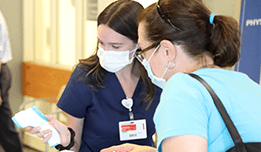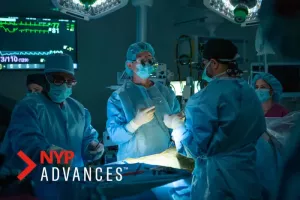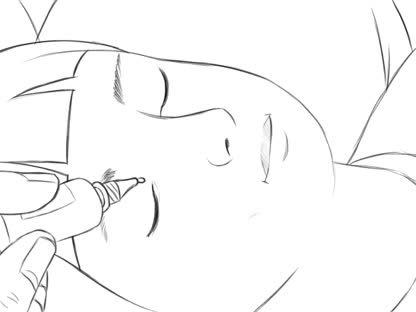Top of the pageCheck Your Symptoms
Eye Problems, Noninjury
Overview
Many people have minor eye, Opens dialog problems, such as eyestrain, irritated eyes, or itchy, scaly eyelids (blepharitis, Opens dialog). These problems may be ongoing (chronic), but they usually aren't serious. Home treatment can relieve the symptoms of many minor eye problems.
Common eye problems
Common types of eye problems include:
- Drainage from the eyes or too much tearing.
- Watery eyes from hay fever, Opens dialog or other seasonal allergies.
- Eye strain or vision changes. Vision changes may happen gradually or suddenly. They include blurred vision and double vision.
- Misaligned eyes or strabismus, Opens dialog (sometimes called cross-eyes).
- Blood in the white of the eye (subconjunctival hemorrhage).
- Eyelid problems. These may be caused by irritation or infection. A stye, Opens dialog is an example.
- Contact lens problems. To avoid eye problems, be sure to follow the directions for cleaning and wearing contact lenses.
- Color blindness, Opens dialog.
- Night blindness.
- Glaucoma, Opens dialog.
- Cataracts, Opens dialog.
- Retinal problems, such as diabetic retinopathy, Opens dialog.
- Red eyes that may be caused by infection, inflammation, or tumors.
- Uveitis, Opens dialog.
- Macular degeneration, Opens dialog.
- Papilledema, Opens dialog.
It's fairly common for the eyes to be irritated or have a scratchy feeling. Pain isn't a common eye problem unless there has been an injury. It's not unusual for the eyes to be slightly sensitive to light. But sudden, painful sensitivity to light is a serious problem. It may be a sign of glaucoma or inflammation of the muscles that control the pupil, Opens dialog (iritis, Opens dialog). Have it checked by your doctor.
People often live with minor eye irritation and problems for a long time, until the irritation or problems become bothersome enough to seek care. People who have skin problems and allergies often have ongoing minor problems with the skin of their eyelids and allergic irritation of the eyes.
Vision changes
Sudden problems such as new vision changes, pain in the eye, or increased drainage are often more serious. They should be checked by a doctor. Eye symptoms that are new or that occur suddenly may be checked by an emergency medicine specialist, Opens dialog.
Ongoing (chronic) eye problems that may be getting worse are usually checked by an eye doctor (ophthalmologist, Opens dialog). A gradual change in your vision or chronic eye problems may include:
- Vision changes, such as:
- Trouble adjusting your vision when you enter a dark room.
- Trouble focusing on close or faraway objects.
- Dark spots in the center of your vision field.
- Lines or edges that look wavy.
- Eyelid problems, such as a stye, Opens dialog or chalazion (a small, hard lump).
- Discharge from or irritation of the eyeball or eyelids. Examples include an infection of the inner edge of the lower eyelid (dacryocystitis, Opens dialog) and pinkeye (conjunctivitis, Opens dialog).
- Sensitivity to light (photophobia, Opens dialog).
- Not being able to see well at night (night blindness). A decrease in night vision may be caused by nearsightedness, cataracts, macular degeneration, or conditions that affect the retina, Opens dialog.
Vision and age
As you reach your 40s and 50s, it's common to have some vision changes and maybe to need glasses. Some of the changes may also cause other symptoms, like headaches and nausea. These symptoms can affect your ability to function.
Some children may have special risks for eye problems. Vision screening is advised for infants who were either born at or before 30 weeks, whose birth weight was below 3.3 lb (1500 g), or who have serious medical conditions. Most vision problems are noticed first by the parents. The first screening is recommended about 4 to 9 weeks after birth.footnote 1
Health Tools help you make wise health decisions or take action to improve your health.
The medical assessment of symptoms is based on the body parts you have.
- If you are transgender or nonbinary, choose the sex that matches the body parts (such as ovaries, testes, prostate, breasts, penis, or vagina) you now have in the area where you are having symptoms.
- If your symptoms aren’t related to those organs, you can choose the gender you identify with.
- If you have some organs of both sexes, you may need to go through this triage tool twice (once as "male" and once as "female"). This will make sure that the tool asks the right questions for you.
Many things can affect how your body responds to a symptom and what kind of care you may need. These include:
- Your age. Babies and older adults tend to get sicker quicker.
- Your overall health. If you have a condition such as diabetes, HIV, cancer, or heart disease, you may need to pay closer attention to certain symptoms and seek care sooner.
- Medicines you take. Certain medicines, such as blood thinners (anticoagulants), medicines that suppress the immune system like steroids or chemotherapy, herbal remedies, or supplements can cause symptoms or make them worse.
- Recent health events, such as surgery or injury. These kinds of events can cause symptoms afterwards or make them more serious.
- Your health habits and lifestyle, such as eating and exercise habits, smoking, alcohol or drug use, sexual history, and travel.
Try Home Treatment
You have answered all the questions. Based on your answers, you may be able to take care of this problem at home.
- Try home treatment to relieve the symptoms.
- Call your doctor if symptoms get worse or you have any concerns (for example, if symptoms are not getting better as you would expect). You may need care sooner.
Pain in adults and older children
- Severe pain (8 to 10): The pain is so bad that you can't stand it for more than a few hours, can't sleep, and can't do anything else except focus on the pain.
- Moderate pain (5 to 7): The pain is bad enough to disrupt your normal activities and your sleep, but you can tolerate it for hours or days. Moderate can also mean pain that comes and goes even if it's severe when it's there.
- Mild pain (1 to 4): You notice the pain, but it is not bad enough to disrupt your sleep or activities.
Pain in children under 3 years
It can be hard to tell how much pain a baby or toddler is in.
- Severe pain (8 to 10): The pain is so bad that the baby cannot sleep, cannot get comfortable, and cries constantly no matter what you do. The baby may kick, make fists, or grimace.
- Moderate pain (5 to 7): The baby is very fussy, clings to you a lot, and may have trouble sleeping but responds when you try to comfort him or her.
- Mild pain (1 to 4): The baby is a little fussy and clings to you a little but responds when you try to comfort him or her.
Symptoms of serious illness may include:
- A severe headache.
- A stiff neck.
- Mental changes, such as feeling confused or much less alert.
- Extreme fatigue (to the point where it's hard for you to function).
- Shaking chills.
Symptoms of serious illness in a baby may include the following:
- The baby is limp and floppy like a rag doll.
- The baby doesn't respond at all to being held, touched, or talked to.
- The baby is hard to wake up.
Many prescription and nonprescription medicines can cause eye problems or changes in vision. A few examples are:
- Antihistamines.
- Some antidepressants (tricyclic antidepressants).
- Erection medicines.
- Medicines for bladder control problems (anticholinergics).
- Medicines (called blood thinners) that prevent blood clots.
- Any kind of medicine that you put in your eye.
Certain health conditions and medicines weaken the immune system's ability to fight off infection and illness. Some examples in adults are:
- Diseases such as diabetes, cancer, heart disease, and HIV/AIDS.
- Long-term alcohol and drug problems.
- Steroid medicines, which may be used to treat a variety of conditions.
- Chemotherapy and radiation therapy for cancer.
- Other medicines used to treat autoimmune disease.
- Medicines taken after organ transplant.
- Not having a spleen.
Certain health conditions and medicines weaken the immune system's ability to fight off infection and illness. Some examples in children are:
- Diseases such as diabetes, cystic fibrosis, sickle cell disease, and congenital heart disease.
- Steroid medicines, which are used to treat a variety of conditions.
- Medicines taken after organ transplant.
- Chemotherapy and radiation therapy for cancer.
- Not having a spleen.
Symptoms of a stroke may include:
- Sudden numbness, tingling, weakness, or paralysis in your face, arm, or leg, especially on only one side of your body.
- Sudden vision changes.
- Sudden trouble speaking.
- Sudden confusion or trouble understanding simple statements.
- Sudden problems with walking or balance.
- A sudden, severe headache that is different from past headaches.
Based on your answers, you may need care soon. The problem probably will not get better without medical care.
- Call your doctor or telehealth provider today to discuss the symptoms and arrange for care.
- If you cannot reach your doctor or telehealth provider or you don't have one, seek care today.
- If it is evening, watch the symptoms and seek care in the morning.
- If the symptoms get worse, seek care sooner.
What are your options for medical care?
Today your options for where to get your medical care are greater than ever before. You may not even have to leave your home to get the care you want and need. You can choose based on what your health problem is and what works best for you.
- Telehealth is a video call with a health care provider. It can be a convenient way to get medical advice or treatment. Some insurers provide access to telehealth that may be available 24 hours a day. Telehealth for less serious problems may cost less and be faster than in-person clinic visits.
- Urgent care and retail clinics are options if you don't have a doctor, you can't or don't want to wait to see your own doctor, or a telehealth visit can’t treat the problem.
- Virtual care from your primary provider or a telehealth service can be delivered through your smartphone, computer, or tablet.
Seek Care Now
Based on your answers, you may need care right away. The problem is likely to get worse without medical care.
- Call your doctor now to discuss the symptoms and arrange for care.
- If you cannot reach your doctor or you don't have one, seek care in the next hour.
- You do not need to call an ambulance unless:
- You cannot travel safely either by driving yourself or by having someone else drive you.
- You are in an area where heavy traffic or other problems may slow you down.
Based on your answers, the problem may not improve without medical care.
- Make an appointment to see your doctor in the next 1 to 2 weeks, or contact your telehealth provider.
- If appropriate, try home treatment while you are waiting for the appointment.
- If symptoms get worse or you have any concerns, call your doctor or telehealth provider. You may need care sooner.
What are your options for medical care?
Today your options for where to get your medical care are greater than ever before. You may not even have to leave your home to get the care you want and need. You can choose based on what your health problem is and what works best for you.
- Telehealth is a video call with a health care provider. It can be a convenient way to get medical advice or treatment. Some insurers provide access to telehealth that may be available 24 hours a day. Telehealth for less serious problems may cost less and be faster than in-person clinic visits.
- Urgent care and retail clinics are options if you don't have a doctor, you can't or don't want to wait to see your own doctor, or a telehealth visit can’t treat the problem.
- Virtual care from your primary provider or a telehealth service can be delivered through your smartphone, computer, or tablet.
Call 911 Now
Based on your answers, you need emergency care.
Call 911 or other emergency services now.
Sometimes people don't want to call 911. They may think that their symptoms aren't serious or that they can just get someone else to drive them. Or they might be concerned about the cost. But based on your answers, the safest and quickest way for you to get the care you need is to call 911 for medical transport to the hospital.
R 14.4.0.0
Home treatment may give some relief from eye symptoms. If you are caring for a child who can't hold still, ask another adult for help if needed.
- Rest your eyes.
This includes taking out your contacts if you use them.
- Don't rub your eyes.
- Try cold or warm compresses.
Use whichever feels the best.
- Gently flush your eyes with water.
Take out your contacts, if you use them. Put your face in a pan of water, or use a low pressure kitchen sink sprayer. Keep your eyes open.
- Protect your eyes.
Avoid bright lights and use dark glasses.
- Moisten your eyes.
If needed, use over-the-counter eyedrops, such as artificial tear solutions.
- Use eyedrops or ointment if needed.
Follow the directions on how to use them.
When to call for help during self-care
Call a doctor if any of the following occur during self-care at home:
- Vision changes, such as blurred vision, loss of vision, or double vision.
- Pain or drainage that does not get better.
- New blood in the eye.
- New sensitivity to light.
- New signs of infection, such as redness, swelling, pus, or a fever.
- Symptoms occur more often or are more severe.
Learn more
Watch
Current as of: July 31, 2024
Author: Ignite Healthwise, LLC Staff
Clinical Review Board
All Ignite Healthwise, LLC education is reviewed by a team that includes physicians, nurses, advanced practitioners, registered dieticians, and other healthcare professionals.
Current as of: July 31, 2024
Author: Ignite Healthwise, LLC Staff
Clinical Review Board
All Ignite Healthwise, LLC education is reviewed by a team that includes physicians, nurses, advanced practitioners, registered dieticians, and other healthcare professionals.








